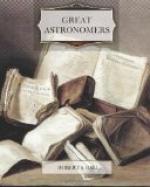In 1721, however, he obtained a grant of 500 pounds from the Board of Ordnance, and accordingly a transit instrument was erected in the same year. Some time afterwards he procured an eight-foot quadrant, and with these instruments, at the age of sixty-four, he commenced a series of observations on the moon. He intended, if his life was spared, to continue his observations for a period of eighteen years, this being, as astronomers know, a very important cycle in connection with lunar movements. The special object of this vast undertaking was to improve the theory of the moon’s motion, so that it might serve more accurately to determine longitudes at sea. This self-imposed task Halley lived to carry to a successful termination, and the tables deduced from his observations, and published after his death, were adopted almost universally by astronomers, those of the French nation being the only exception.
Throughout his life Halley had been singularly free from illness of every kind, but in 1737 he had a stroke of paralysis. Notwithstanding this, however, he worked diligently at his telescope till 1739, after which his health began rapidly to give way. He died on January 14th, 1742, in the eighty-sixth year of his age, retaining his mental faculties to the end. He was buried in the cemetery of the church of Lee in Kent, in the same grave as his wife, who had died five years previously. We are informed by Admiral Smyth that Pond, a later Astronomer Royal, was afterwards laid in the same tomb.
Halley’s disposition seems to have been generous and candid, and wholly free from anything like jealousy or rancour. In person he was rather above the middle height, and slight in build; his complexion was fair, and he is said to have always spoken, as well as acted, with uncommon sprightliness. In the eloge pronounced upon him at the Paris Academie Des Sciences, of which Halley had been made a member in 1719 it was said, “he possessed all the qualifications which were necessary to please princes who were desirous of instruction, with a great extent of knowledge and a constant presence of mind; his answers were ready, and at the same time pertinent, judicious, polite and sincere.”
[Plate: Greenwich observatory in Halley’s time.]
Thus we find that Peter the Great was one of his most ardent admirers. He consulted the astronomer on matters connected with shipbuilding, and invited him to his own table. But Halley possessed nobler qualifications than the capacity of pleasing Princes. He was able to excite and to retain the love and admiration of his equals. This was due to the warmth of his attachments, the unselfishness of his devotion to his friends, and to a vein of gaiety and good-humour which pervaded all his conversation.




